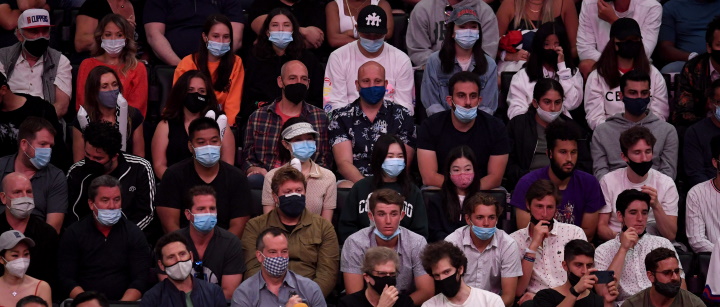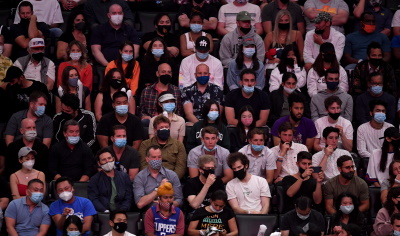
Citing new data on the delta variant, the Centers for Disease Control and Prevention recommended that fully vaccinated people wear face masks indoors in some parts of the country.
 The July 27 updated guidance comes two months after the CDC said those who are fully vaccinated largely did not need to wear masks indoors, except in a few settings, including correctional and homeless facilities, and on public transportation.
The July 27 updated guidance comes two months after the CDC said those who are fully vaccinated largely did not need to wear masks indoors, except in a few settings, including correctional and homeless facilities, and on public transportation.
The latest recommendations say the fully vaccinated should mask up in indoor public places in areas of the country that have substantial or high transmission of the coronavirus.
To check whether your county has low, moderate, substantial or high transmission, use the CDC’s COVID Data Tracker.
The CDC said the updated guidance was due to new evidence on the delta variant, which is more contagious than earlier versions of the virus.
“The delta variant is showing every day its willingness to outsmart us and to be an opportunist in areas where we have not shown a fortified response against it,” CDC Director Dr. Rochelle Walensky said in the July 27 media briefing announcing the new mask recommendations.
While only a “very small amount of transmission” in the country is among those who are fully vaccinated, Walensky said, research on outbreak clusters has shown that those who had rare “breakthrough” infections had similar viral loads as those who were unvaccinated. That information, which is different from what was observed with the alpha variant, led public health experts to believe vaccinated individuals could transmit the delta variant to others, she said.
The delta variant is the dominant variant in the U.S., making up 82.2% of the cases in the two-week period ending July 17, according to the most recent CDC data available.
As we’ve explained, the authorized COVID-19 vaccines in the U.S. have been shown to be largely effective against the delta variant, albeit somewhat less so against symptomatic disease compared with other variants.

For instance, Public Health England reported in the New England Journal of Medicine on July 21 that the real-world effectiveness of two doses of the Pfizer/BioNTech vaccine was 88.0% against the delta variant in preventing symptomatic disease, compared with 93.7% against the alpha variant. With only one dose, the difference in effectiveness was more pronounced, from 47.5% against alpha to 35.6% against delta, underscoring what other studies have found about the importance of getting both doses of the mRNA vaccines.
Walensky emphasized that the risk of getting a symptomatic infection when exposed to the delta variant was reduced sevenfold when someone was fully vaccinated, and she said there was a twentyfold reduction for hospitalizations and deaths.
But she cited “worrisome” data on the ability of fully vaccinated individuals to transmit the delta variant if they did become infected. An updated CDC science brief mentioned one study in Houston that found “a significantly higher rate of breakthrough infections in fully vaccinated people” with the delta variant compared with other variants. It also referred to studies from India — and in footnotes cited one that has not yet been peer reviewed– that found “relatively high viral loads and larger cluster sizes associated with infections with Delta, regardless of vaccination status.”
“These early data suggest that breakthrough Delta infections are transmissible,” the CDC said. “Unpublished data are consistent with this, and additional data collection and studies are underway to understand the level and duration of transmissibility from Delta vaccine breakthrough infections in the United States and other settings.”
The CDC will publish more data on this issue on July 30, CDC spokesperson Jasmine Reed told us.
The New Mask Recommendations
The CDC’s new recommendations pertain to fully vaccinated people. The agency continues to advise those who aren’t fully vaccinated to wear a mask when in indoor public settings.
Generally, the CDC says masks aren’t needed outdoors, but unvaccinated people might consider it if they are in crowded locations in close contact with others.
As for the new guidance for the fully vaccinated, in addition to recommending mask use when in indoor public places in areas of substantial or high transmission, the CDC has recommendations for specific situations:
Immunocompromised: The fully vaccinated might decide to wear a mask even in areas of low or moderate transmission, “if they are immunocompromised or at increased risk for severe disease from COVID-19, or if they have someone in their household who is immunocompromised, at increased risk of severe disease or not fully vaccinated.” The CDC has said there is limited information on how well immunocompromised individuals are protected from the coronavirus by the COVID-19 vaccines.
Public transit: The CDC also continues to require face masks “on planes, buses, trains, and other forms of public transportation.”
K-12 schools: Everyone who is indoors in K-12 schools should wear a mask, whether they are vaccinated or not, the CDC recommended. In the July 27 briefing, Walensky said that guidance, too, was based on data on the delta variant and a low vaccination rate among children age 12 to 17.
COVID-19 exposure: The CDC also added a recommendation for fully vaccinated people to get tested three to five days after an exposure to someone with COVID-19, or suspected to have COVID-19, and to wear a mask when indoors in public places until the test comes back negative, or for 14 days.
What’s Substantial or High Transmission?
As we said, the CDC’s COVID Data Tracker shows the level of virus transmission across the country, by county.
The designations — low, moderate, substantial and high — are based on the number of new COVID-19 cases per 100,000 population over seven days, or the percentage of COVID-19 tests that came back positive over seven days — whichever measure indicates a higher level of transmission.
As of July 29, nearly half of U.S. counties — 49.94% — had a high level of community transmission, and 16.68% had a substantial level.
A county has a high level of transmission if the new cases in the past seven days are 100 or more per 100,000 people or if the test positivity rate is 10% or higher. The thresholds for substantial transmission are 50-99.9 cases per 100,000 people or a test positivity rate of 8% to 9.99%.
The information is updated daily with new data on cases and testing, so a county’s designation can fluctuate, day by day. For instance, Washington, D.C.’s moderate designation on July 27 went up to substantial the next day, and back down to moderate the following day.
In the July 27 briefing, Walensky said the new data on the delta variant “weighs heavily on me” and that “this was not a decision that was taken lightly.”
“We thought it was important for people to understand that they can pass the disease on to someone else,” she said.
Editor’s note: SciCheck’s COVID-19/Vaccination Project is made possible by a grant from the Robert Wood Johnson Foundation. The foundation has no control over our editorial decisions, and the views expressed in our articles do not necessarily reflect the views of the foundation. The goal of the project is to increase exposure to accurate information about COVID-19 and vaccines, while decreasing the impact of misinformation.
The post A Guide to the CDC’s Updated Mask Recommendations appeared first on FactCheck.org.


